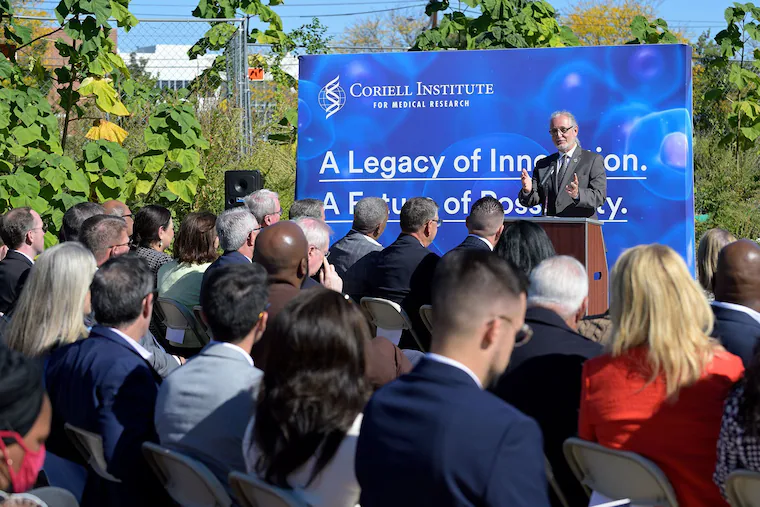
The Coriell Institute for Medical Research is building a new home in Camden, which will expand its ability to house collections of human blood and tissue samples in biobanks, conduct research, and incubate emerging biotech talent.
The independent biomedical research institute, founded in 1953, officially broke ground on the new campus on Thursday, with expectations to open the building in early 2028.
Coriell has outgrown its current facility at 403 Haddon Ave., said Jean-Pierre Issa, a physician-scientist and president of the institute. Between launching a new cancer research center in 2023 and acquiring their sixth National Institutes of Health biobank this September, they needed space to recruit more faculty and expand their biobanking program.
“We took advantage of this opportunity to dream bigger,” he said.
The new seven-acre space, located half a mile away on the 1300 block of Walnut Street, will house a mixed-use building, half of which will serve as its headquarters.
The other half will be a 45,000-square-foot biotech incubator space that the institute is developing in conjunction with the New Jersey Economic Development Authority. At least 15 different biotechnology companies will be recruited to use the space, Issa said, as part of the Strategic Innovation Center program introduced by New Jersey Gov. Phil Murphy.
In the long term, Coriell plans to add more buildings on the campus and foster partnerships between industry and academia.
“The project will create permanent jobs and construction jobs, moreover, it will attract world-class scientists and biopharmaceutical companies. This will be a tremendous economic boost to our city, South Jersey, and the region,” said Camden Mayor Victor G. Carstarphen in a statement.
A legacy of biobanking
The Coriell Institute is home to one of the nation’s oldest biobanks, which is a collection of biological samples used for research.
The institute’s founder, physician-scientist Lewis L. Coriell, had developed technology that allowed scientists to safely grow and store human cells in the lab. His laboratory technique made it possible for scientists to grow the cells needed to carry out poliovirus research and develop the successful vaccine.
It also made it easier to store human cells from any individual, Issa said, which is essential for biobanking.
Interested in genetic diseases, Coriell convinced the NIH to develop a human genetics biobank in the 1970s. Today that collection, still housed at the Coriell Institute, has grown to include thousands of different genetic diseases.
Biobanks are a “research accelerator,” Issa explained, allowing researchers interested in a disease to gather patient samples without needing to be physically close to the patient. The institute’s samples have contributed to research into the causes of many rare genetic diseases.
“A researcher in any country who wants to advance science and cure disease can come to our biobanks and obtain these samples,” Issa said.
The institute has since acquired several more NIH biobanks, in addition to other collections of cells and DNA, and has distributed these materials to over 80 countries.
This September, they were awarded the National Institutes of Mental Health’s biobank — their largest yet — which includes samples from about 200,000 different individuals, spanning 200 clinical trials and millions of samples.
“It’s part of the growing biobanking enterprise that we have,” Issa said.